
Daffodils are iconic spring flowers that bring a touch of colorful charm to any garden. While most people are familiar with the classic yellow daffodils, there is a fascinating world of rare daffodil cultivars waiting to be discovered. Most of them are heirloom varieties with a rich history. And all of them have remarkable blooms.
So keep reading to discover nine rare types of daffodils that might be harder to find but are worth the search to see these exceptional flowers blooming outside your door. And enjoy the three daffodil breeder spotlight sections we sprinkled throughout this piece. We find it interesting to learn more about the people who make some of these rare daffodils come to life.
But first, check out the quick reference list below of the 13 daffodil divisions used to identify these beloved bulb flowers. These divisions developed by the Royal Horticultural Society help us all recognize the many different types of daffodils.

Bulbocodium daffodils like ‘White Petticoat’ belong to division #10 of the 13 daffodil divisions.
©Walter Erhardt/Shutterstock.com
Daffodil Identification: The 13 Daffodil Divisions
Over time, the Royal Horticultural Society designed a daffodil classification system that became the modern standard worldwide. Every daffodil cultivar belongs to at least one of the following divisions. And every division designates each grouping’s growth habits and physical traits.
For more information about each division and its traits, click the links provided below.
- Division #1: Trumpet Daffodils
- Division #2: Large-Cupped Daffodils
- Division #3: Small-Cupped Daffodils
- Division #4: Double Daffodils
- Division #5: Triandrus Daffodils
- Division #6: Cyclamineus Daffodils
- Division #7: Jonquilla Daffodils
- Division #8: Tazetta Daffodils
- Division #9: Poeticus Daffodils
- Division #10: Bulbocodium Hybrids
- Division #11a: Split-Cupped Collar Daffodils
- Division #11b: Split-Cupped Papillion Daffodils
- Division #12: Other Cultivars Daffodils
- Division #13: Daffodils Distinguished Only by Botanical Name
Are you ready to learn more about some marvelous and rare types of daffodils? Scroll on and enjoy!
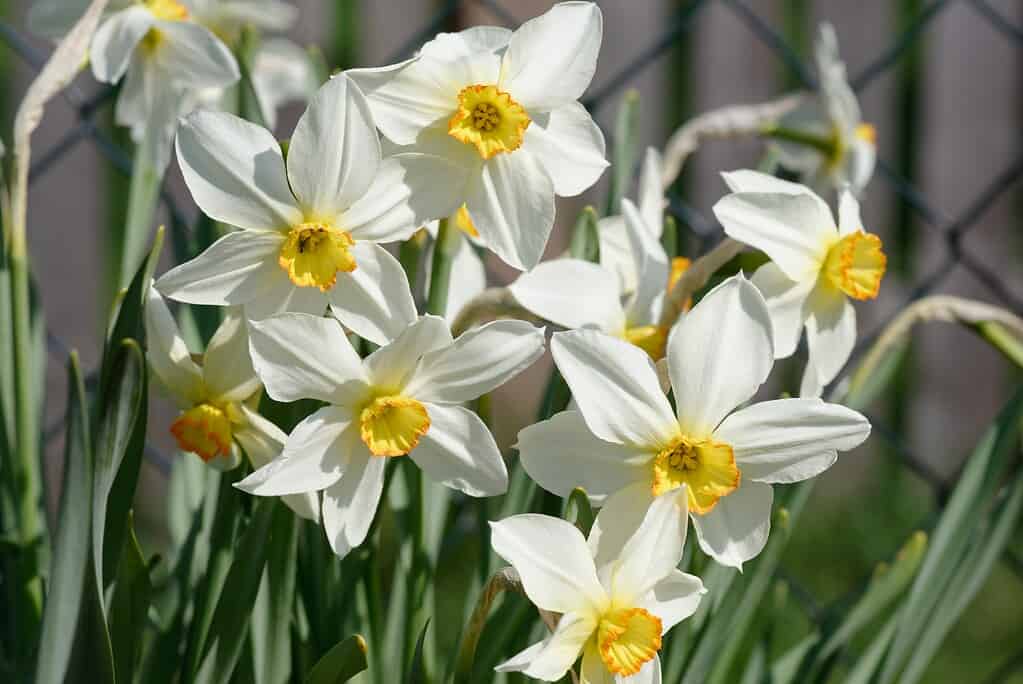
The ‘
Albatross
‘ cultivar is a rare type of daffodil and an heirloom variety from the late 1800s.
©Walter Erhardt/Shutterstock.com
1. ‘Albatross’ Daffodil
- Botanical Name: Narcissus ‘Albatross’
- Common Names: ‘Albatross’ Daffodil, ‘Albatross’ Small-Cupped Daffodil
- Daffodil Division: Small-Cupped, Division #3
- USDA Hardiness Zones: 4-8
- Bloom Seasons: Mid to Late Spring
- Sunlight Needs: Full Sun to Light Shade
- Mature Height: 18-20 inches tall
- Flower Colors: Large, pure white petals with bright yellow-orange cups
The ‘Albatross’ is a rare type of daffodil that makes gardeners cheer when it’s back in stock with bulb suppliers. This small-cupped daffodil has propeller-like white petals and frilly yellow-orange cups. ‘Albatross’ is also an heirloom daffodil registered before 1891.
This showy bicolor daffodil starts blooming in mid-to-late spring and features 4-6 inch blooms. And this colorful, rare daffodil attracts bees and butterflies to the garden.
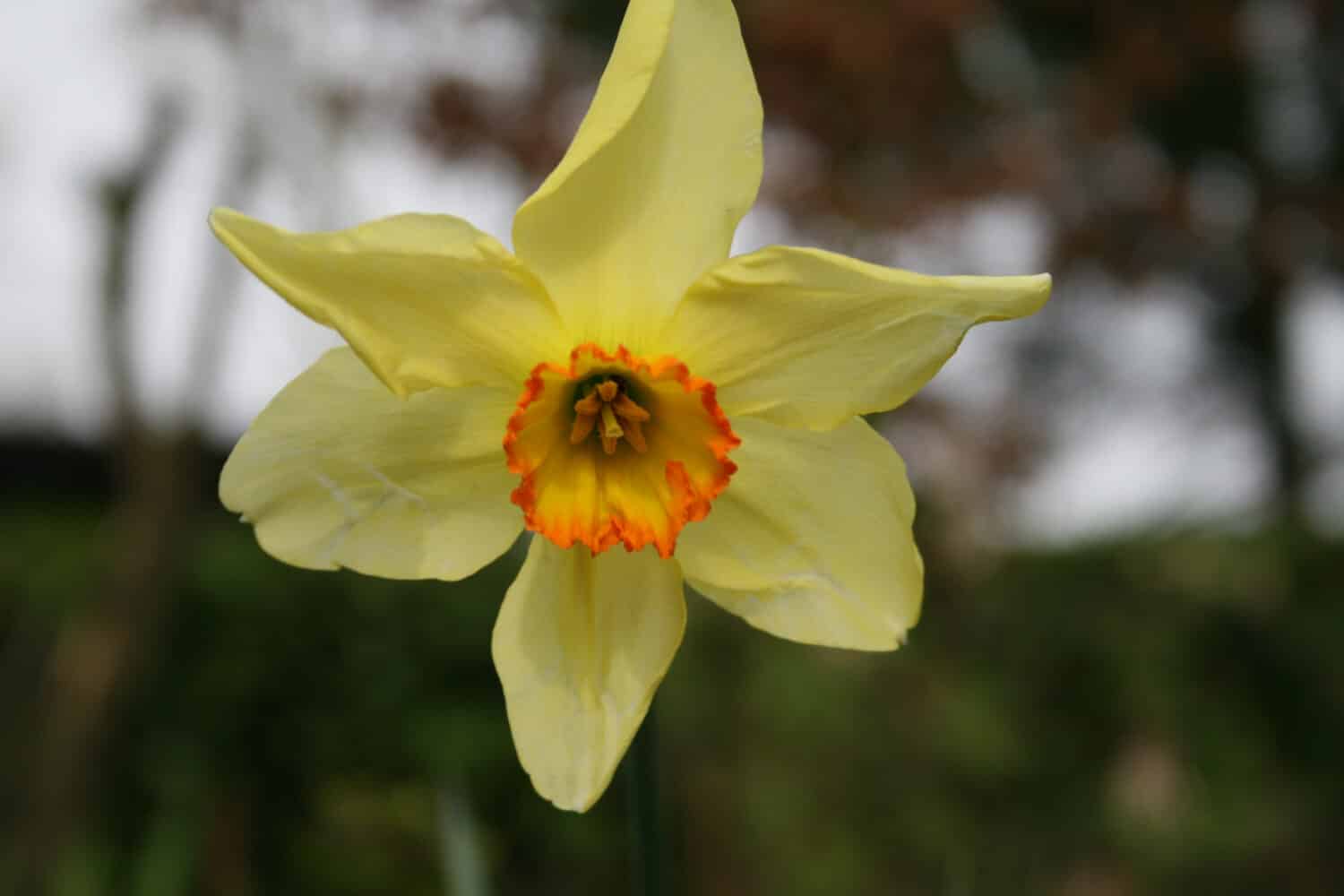
The ‘Bath’s Flame’ daffodil originates before 1913 from British breeder Reverend George Engleheart.
©Geert Naessens/Shutterstock.com
2. ‘Bath’s Flame’ Daffodil
- Botanical Name: Narcissus ‘Bath’s Flame’
- Common Names: ‘Bath’s Flame’ Daffodil, ‘Bath’s Flame’ Small-Cupped Daffodil
- Daffodil Division: Small-Cupped, Division #3
- USDA Hardiness Zones: 3-10
- Bloom Seasons: Mid-Spring
- Sunlight Needs: Full Sun to Light Shade
- Mature Height: 16-18 inches tall
- Flower Colors: Soft yellow petals with a vivid orange-red cup.
The ‘Bath Flame’ daffodil cultivar has been around since 1913, but don’t be surprised if bulbs for this heirloom flower are in limited supply. This rare type of daffodil is another bicolor variety with light yellow petals and vibrant reddish-orange cups. In addition, ‘Bath Flame’ is a small-cupped daffodil with spreading petals and a short, ribbed cup.
Daffodil Breeder Spotlight: Reverend George Engleheart
Both the ‘Albatross’ (see above) and ‘Bath Flame’ daffodil cultivars were introduced by the late Reverend George Engleheart. Rev. Engleheart (1851–1936) was the vicar of a country church and an amateur daffodil breeder in England. He produced around 700 named daffodil varieties in his lifetime, many of them award-winning. As a result, Rev. Engleheart made his way into the history books as one of the greatest daffodil breeders worldwide.

The ‘Broughshane’ heirloom daffodil is named for the flower breeder’s Irish hometown.
©Walter Erhardt/Shutterstock.com
3. ‘Broughshane’ Daffodil
- Botanical Name: Narcissus ‘Broughshane’
- Common Names: ‘Broughshane’ Daffodil, ‘Broughshane’ Trumpet Daffodil
- Daffodil Division: Trumpet Daffodil, Division #1
- USDA Hardiness Zones: 4-8
- Bloom Seasons: Mid-Spring
- Sunlight Needs: Full Sun to Light Shade
- Mature Height: 12-16 inches tall
- Flower Colors: White petals with cream and amber cups
This rare daffodil takes us back to Ireland, where the ‘Broughshane’ cultivar came on the scene pre-1938. The ‘Broughshane’ is a pale pastel beauty with white petals and creamy cups that shimmer with just a hint of amber. Its world-renowned hybridizer, Guy Wilson, named this daffodil after his hometown in Northern Ireland.
This divine heirloom daffodil belongs to division #1 as a trumpet daffodil. With its big blooms and huge frilly cups, the ‘Broughshane’ is a standout cut flower for arrangements. When you can find it, that is!
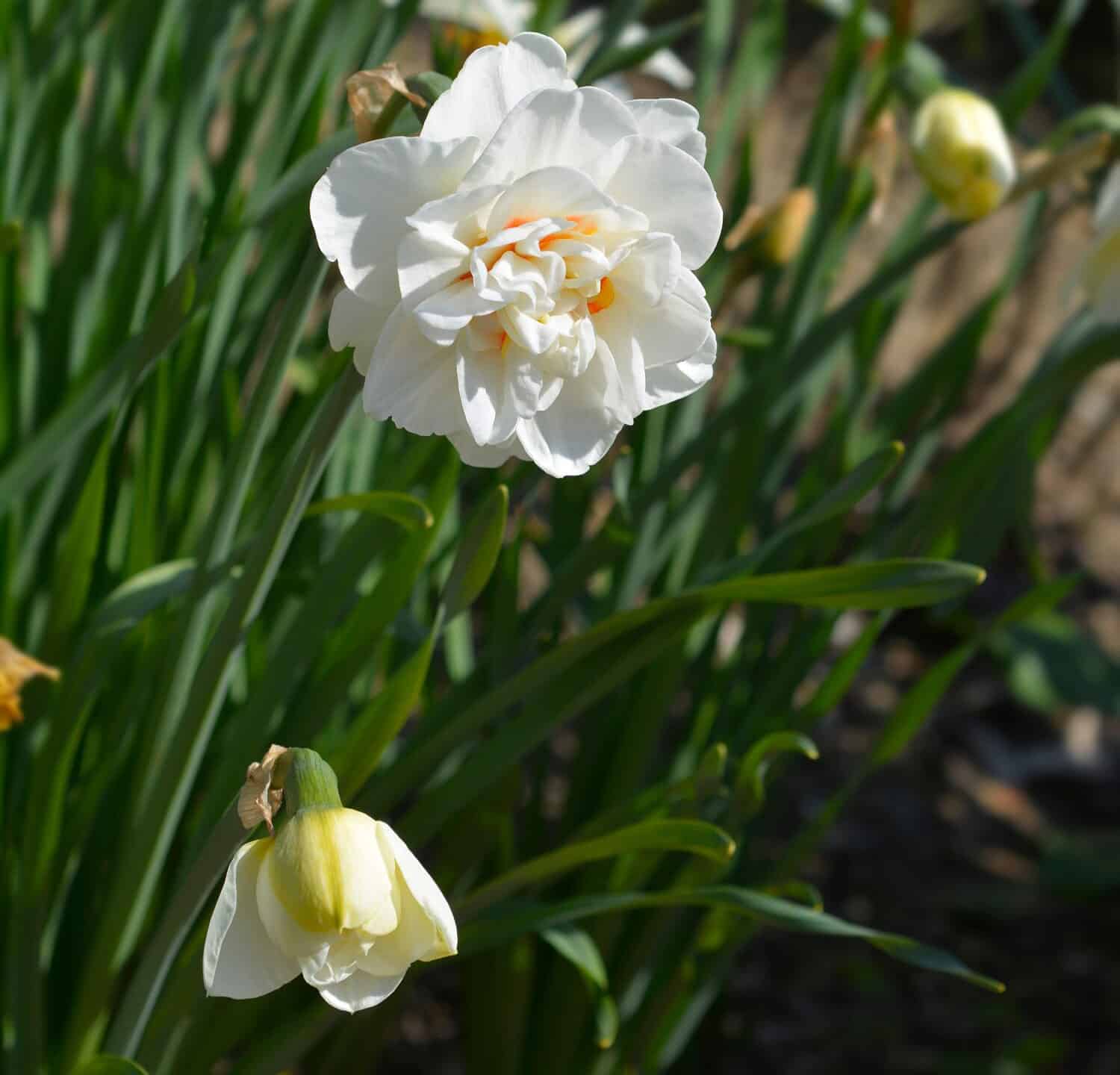
The ‘Flower Drift’ cultivar is a rare type of daffodil with a spicy scent.
©Nahhana/Shutterstock.com
4. ‘Flower Drift’ Daffodil
- Botanical Name: Narcissus ‘Flower Drift’
- Common Names: ‘Flower Drift’ Daffodil, ‘Flower Drift’ Double Daffodil
- Daffodil Division: Double Daffodil, Division #4
- USDA Hardiness Zones: 4-9
- Bloom Seasons: Early to Mid-Spring
- Sunlight Needs: Full Sun to Light Shade
- Mature Height: 12-16 inches tall
- Flower Colors: White petals and a fluffy yellow-orange cup
‘Flower Drift’ is a rare type of daffodil with fluttery double sets of white petals and bright orange-yellow cups. The extra fluffy look of double daffodils like ‘Flower Drift’ gives them a style similar to peonies.
The ‘Flower Drift’ cultivar has a pleasing spicy scent and produces 4-inch blooms by mid-spring. It’s also an heirloom daffodil from 1966.
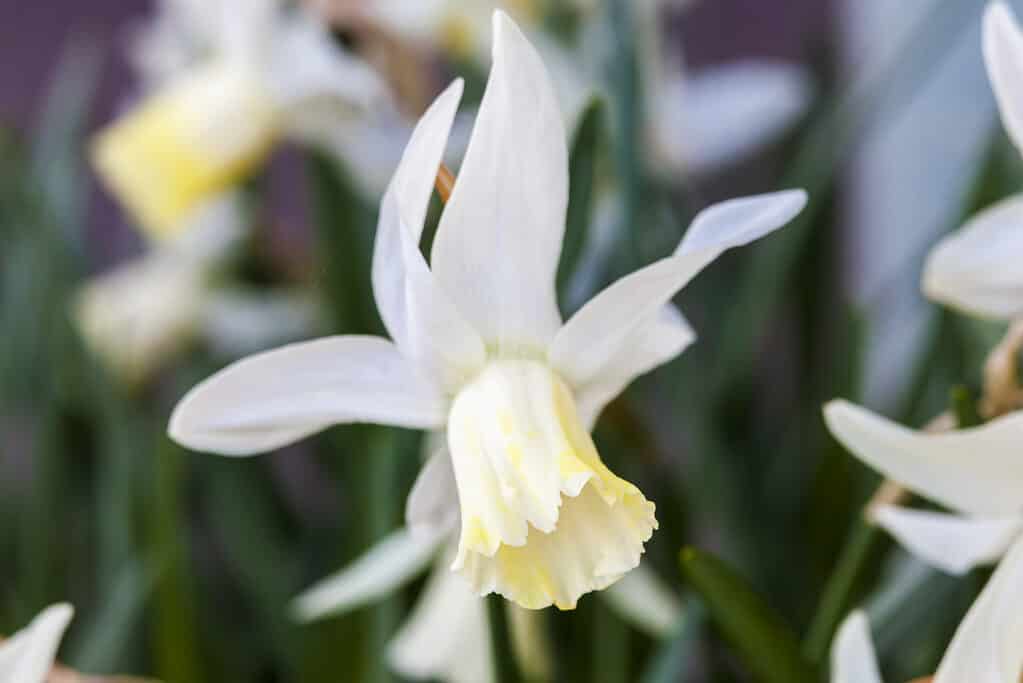
A ‘Jenny’ daffodil is a rare cyclamineus variety with strongly reflexed petals.
©iStock.com/TonyBaggett
5. ‘Jenny’ Daffodil
- Botanical Name: Narcissus ‘Jenny’
- Common Names: ‘Jenny’ Daffodil, ‘Jenny’ Cyclamineus Daffodil
- Daffodil Division: Cyclamineus Daffodil, Division #6
- USDA Growing Zones: 3-9
- Bloom Seasons: Early to Mid-Spring
- Sunlight Needs: Full Sun to Light Shade
- Mature Height: 8-10 inches tall
- Flower Colors: White petals with yellow cups that mature to creamy white
Not only is the ‘Jenny’ cultivar a rare daffodil, but it’s also a dwarf variety and a reverse bicolor daffodil. As a miniature daffodil, ‘Jenny’ grows about 8–10 inches tall. And as a reverse bicolor daffodil, its flower cups change color. In this case, the center cups mature from yellow to cream against the backdrop of this daffodil’s striking reflexed white petals.
‘Jenny’ is also a cyclamineous daffodil (division #6) and heirloom variety from the 1930s.
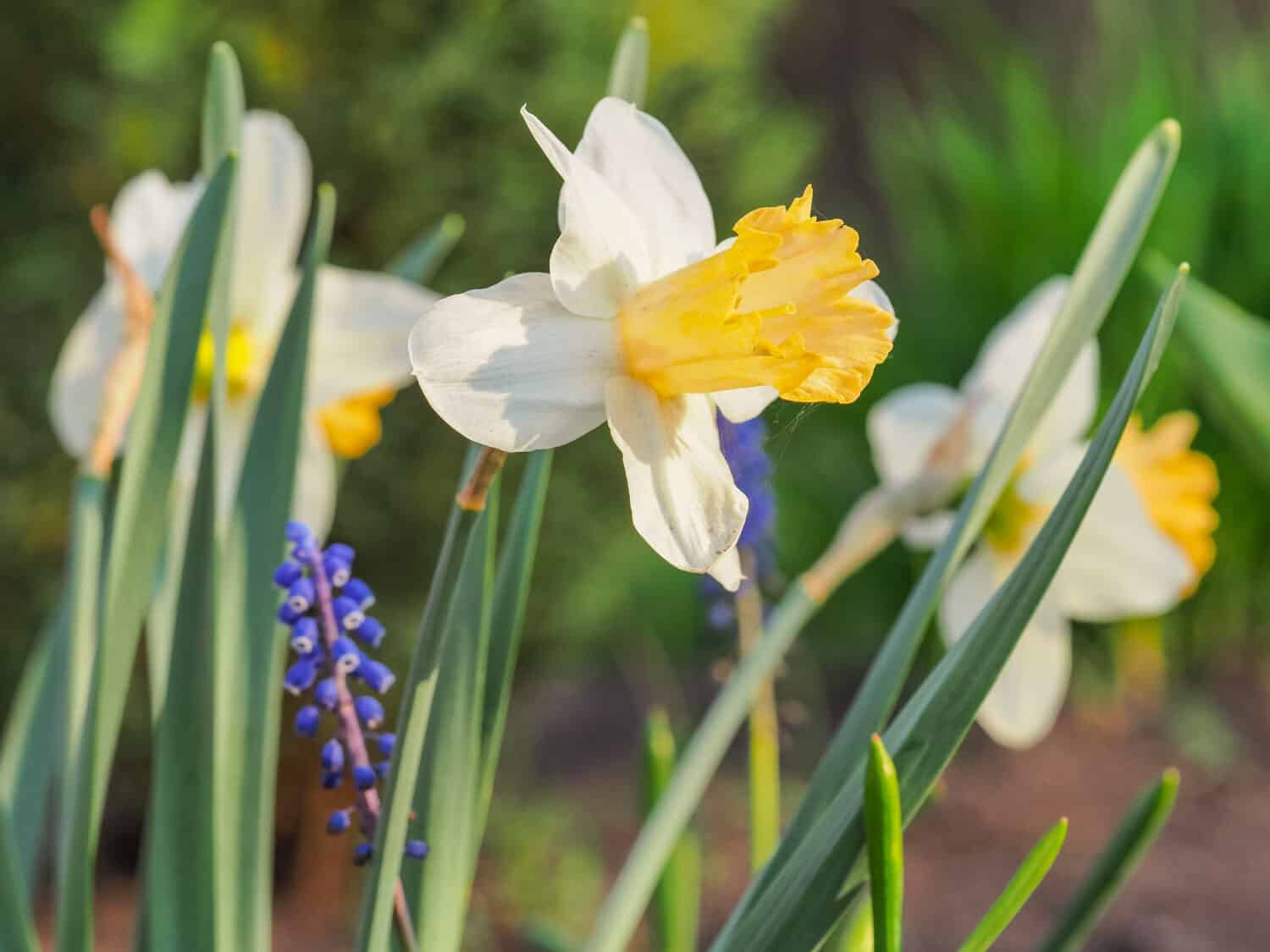
The ‘John Evelyn’ daffodil is a rare large-cupped cultivar from breeder William F.M. Copeland.
©LifeCollectionPhotography/Shutterstock.com
6. ‘John Evelyn’ Daffodil
- Botanical Name: Narcissus ‘John Evelyn’
- Common Names: ‘John Evelyn’ Daffodil, ‘John Evelyn’ Large-Cupped Daffodil
- Daffodil Division: Large-Cupped Daffodil, Division #2
- USDA Growing Zones: 4-8
- Bloom Seasons: Early to Mid-Spring
- Sunlight Needs: Full Sun to Light Shade
- Mature Height: 16-18 inches tall
- Flower Colors: Bright white petals with lemon yellow cups
The ‘John Evelyn’ cultivar is a rare historic daffodil and a large-cupped variety. Its big, showy flowers feature white petals with orange-gold ruffled trumpets that mature to lemon yellow.
Daffodil Breeder Spotlight: William F.M. Copeland
The ‘John Evelyn’ bicolor daffodil dates back to before 1920 when British breeder William F.M. Copeland was naming new hybrids after his family members. The ‘John Evelyn’ daffodil’s namesake is Copeland’s only son. In addition, Copeland named daffodil cultivars after his wife (‘Mrs. William Copeland’ daffodil) and his daughters (‘Mary Copeland’ daffodil and ‘Irene Copeland’ daffodil).
US heirloom bulb supplier Old House Gardens tells more of the Copeland family history learned from a granddaughter of W.F.M. Copeland. Apparently, her grandfather was waiting to develop an extraordinary new hybrid to call John Copeland after his son. However, the cultivar he named ‘John Evelyn’ turned out to be one of the best he ever created. So a daffodil called John Copeland never came to be.
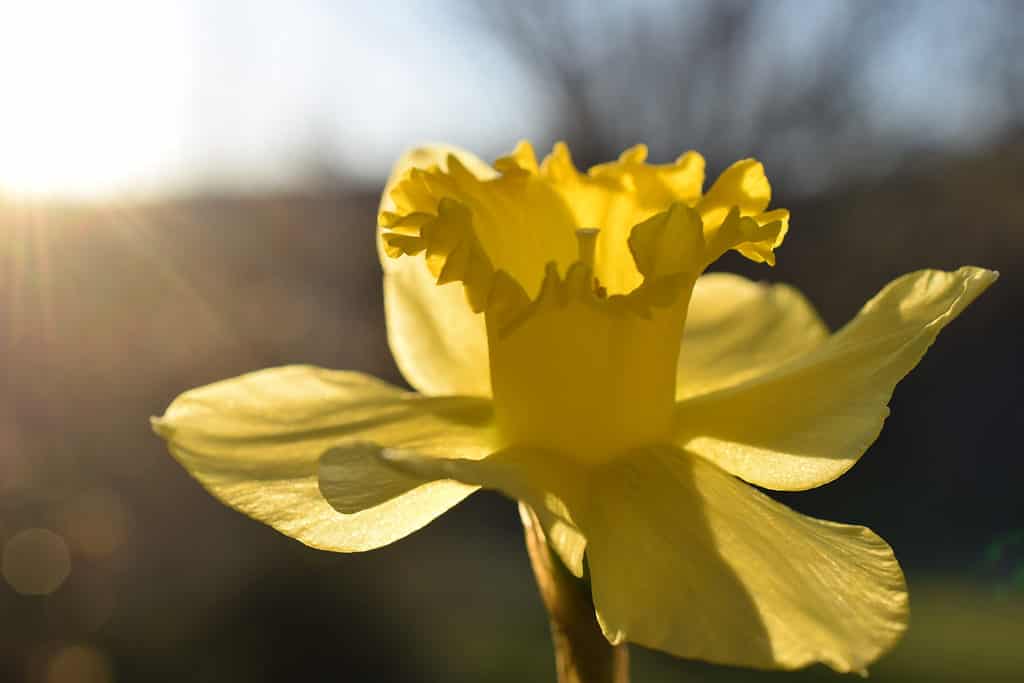
The ‘King Alfred’ cultivar is such a beloved rare daffodil that it has the nickname “King of Daffodils.”
©Tracy Burroughs Brown/Shutterstock.com
7. ‘King Alfred’ Daffodil
- Botanical Name: Narcissus ‘King Alfred’
- Common Names: ‘King Alfred’ Daffodil, The Lent Lily
- Daffodil Division: Trumpet Daffodil, Division #1
- USDA Growing Zones: 3-8
- Bloom Seasons: Early to Mid-Spring
- Sunlight Needs: Full Sun to Light Shade
- Mature Height: 12-26 inches tall
- Flower Colors: Classic golden yellow daffodil
The ‘King Alfred’ cultivar is a standout trumpet daffodil that’s harder to find these days but is still beloved for its majestic beauty. This rare type of daffodil from the late 1800s is golden yellow and is still a hardy plant in Zones 3–8.
This king of daffodils is such a sought-after heirloom flower that some modern “improved” versions of ‘King Alfred’ might be available. However, if you want the original ‘King Alfred’ heirloom bulbs, have patience and get on some bulb supplier waiting lists.

Delicate ‘La Riante’ daffodils are rare heirloom bulb flowers from the 1930s.
©Graham Prentice/Shutterstock.com
8. ‘La Riante’ Daffodil
- Botanical Name: Narcissus ‘La Riante’
- Common Names: ‘La Riante’ Daffodil, ‘La Riante’ Small-Cupped Daffodil
- Daffodil Division: Small-Cupped Daffodil, Division #3
- USDA Growing Zones: 5-8
- Bloom Seasons: Early to Mid-Spring
- Sunlight Needs: Full Sun to Light Shade
- Mature Height: 14-20 inches tall
- Flower Colors: Pure white petals with bright reddish-orange small cups
‘La Riante’ means “laughing girl” in French, and this delicate daffodil is sure to make you smile. And ‘La Riante’ is a rare small-cupped variety with a striking orange cup dazzling from the middle of its pure white petals.
The reason ‘La Riante’ daffodils are delicate is that they can get sunburned if left for too many hours in the hot sun. So make sure these beauties get some afternoon shade during the hottest weeks of their blooming season.
The ‘La Riante’ daffodil brings her giggling energy to the garden with bright blooms in early to mid-spring. This rare daffodil from the early 1930s also smells divine.
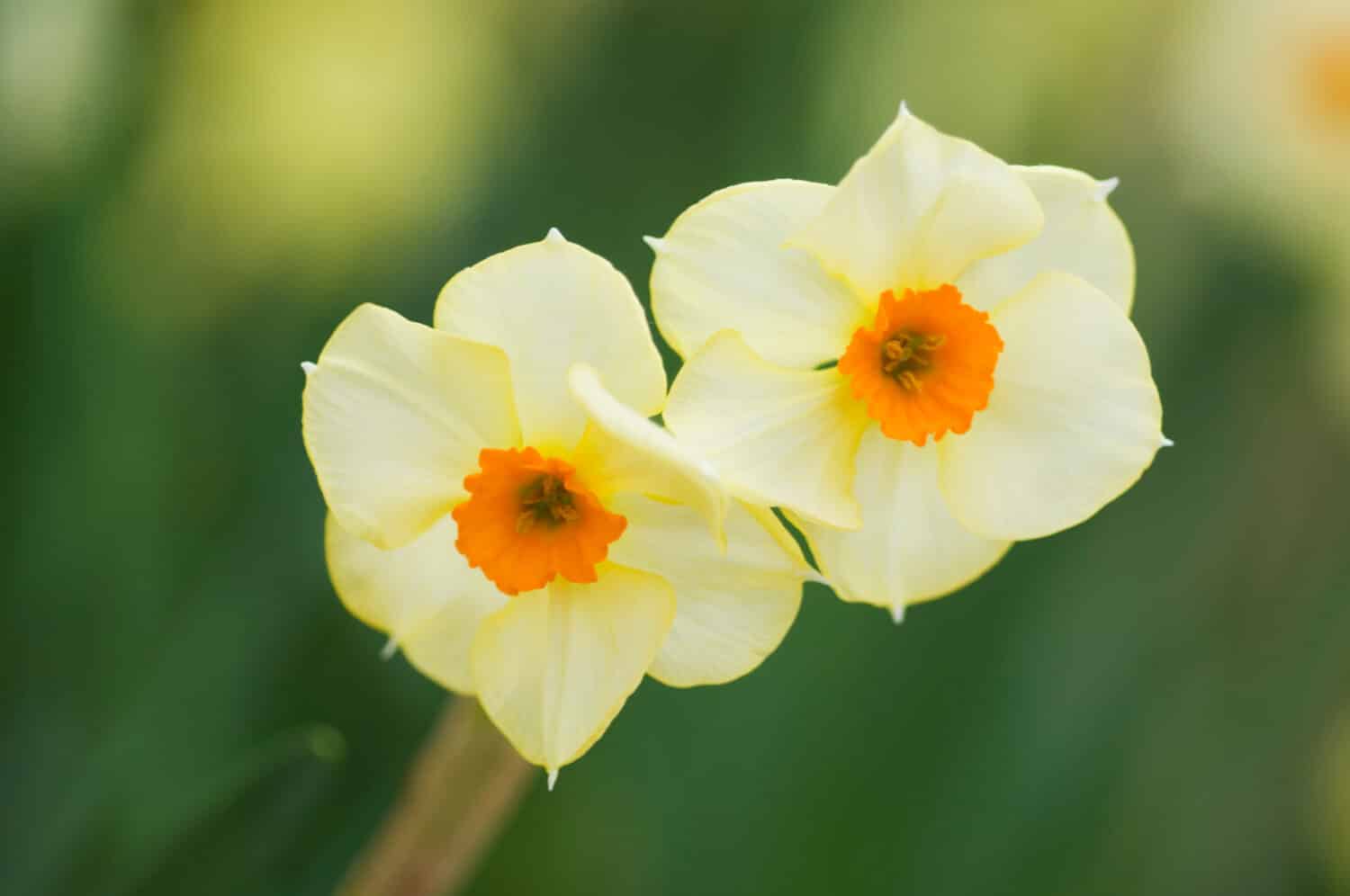
Pretty ‘Scarlet Gem’ daffodils are rare hybrids introduced by Cornwall breeder P.D. Williams.
©J Need/Shutterstock.com
9. ‘Scarlet Gem’ Daffodil
- Botanical Name: Narcissus ‘Scarlet Gem’
- Common Names: ‘Scarlet Gem’ Daffodil, ‘Scarlet Gem’ Tazetta Daffodil
- Daffodil Division: Tazetta Daffodil, Division #8
- USDA Growing Zones: 5-9
- Bloom Seasons: Mid to Late Spring
- Sunlight Needs: Full Sun to Light Shade
- Mature Height: 12-26 inches
- Flower Colors: Primrose petals with bright orange cups
The ‘Scarlet Gem’ cultivar is a rare type of daffodil that loves warm climates. This tazetta variety has spreading yellow petals and a small tangerine center cup. In addition, it has a sweet scent and grows to the standard daffodil size of 1-2 feet.
‘Scarlet Gem’ is from the early 1900s and is one of the many hybrids created by British daffodil breeder P.D. Williams.
Daffodil Breeder Spotlight: P.D. Williams
You might know the late Percival Dacres Williams as P.D. Williams or Cornwall’s Daffodil King. Whether you know of him or not, P.D. Williams (1865–1935) was pivotal to the development and advancement of the Holland and American daffodil industries.
In the US, Williams was one of the favorite breeders of New York’s Horticultural Society during the 1920s and 1930s. For many years during the post-war daffodil boom, Cornwall-based Williams was also the darling of wealthy daffodil collectors across the US and international markets. And he was often paid in gold.
Williams is responsible for registering over 500 daffodil hybrids and was a grower of thousands of daffodils in his lifetime.
Summary of 9 Rare Types of Daffodil
Here are the 9 Rare Types of Daffodils:
| Rank | Daffodil |
|---|---|
| 1 | ‘Albatross’ Daffodil |
| 2 | ‘Bath’s Flame’ Daffodil |
| 3 | ‘Broughshane’ Daffodil |
| 4 | ‘Flower Drift’ Daffodil |
| 5 | ‘Jenny’ Daffodil |
| 6 | ‘John Evelyn’ Daffodil |
| 7 | ‘King Alfred’ Daffodil |
| 8 | ‘La Riante’ Daffodil |
| 9 | ‘Scarlet Gem’ Daffodil |
Rare types of daffodils are remarkable and worth the wait.
Daffodil enthusiasts who love the heirloom varieties know that the rare cultivars that still exist today are hardy and magnificent. And they know that patience is a virtue when it comes to waiting for the rare daffodils to show up on supplier websites again. They’re worth the wait because the rare daffodils that still exist have stood the test of time. Through climate change and competition from younger hybrids, the rare daffodils help keep the history of our ancestors’ gardens alive.
The photo featured at the top of this post is © Nahhana/Shutterstock.com
Thank you for reading! Have some feedback for us? Contact the AZ Animals editorial team.






